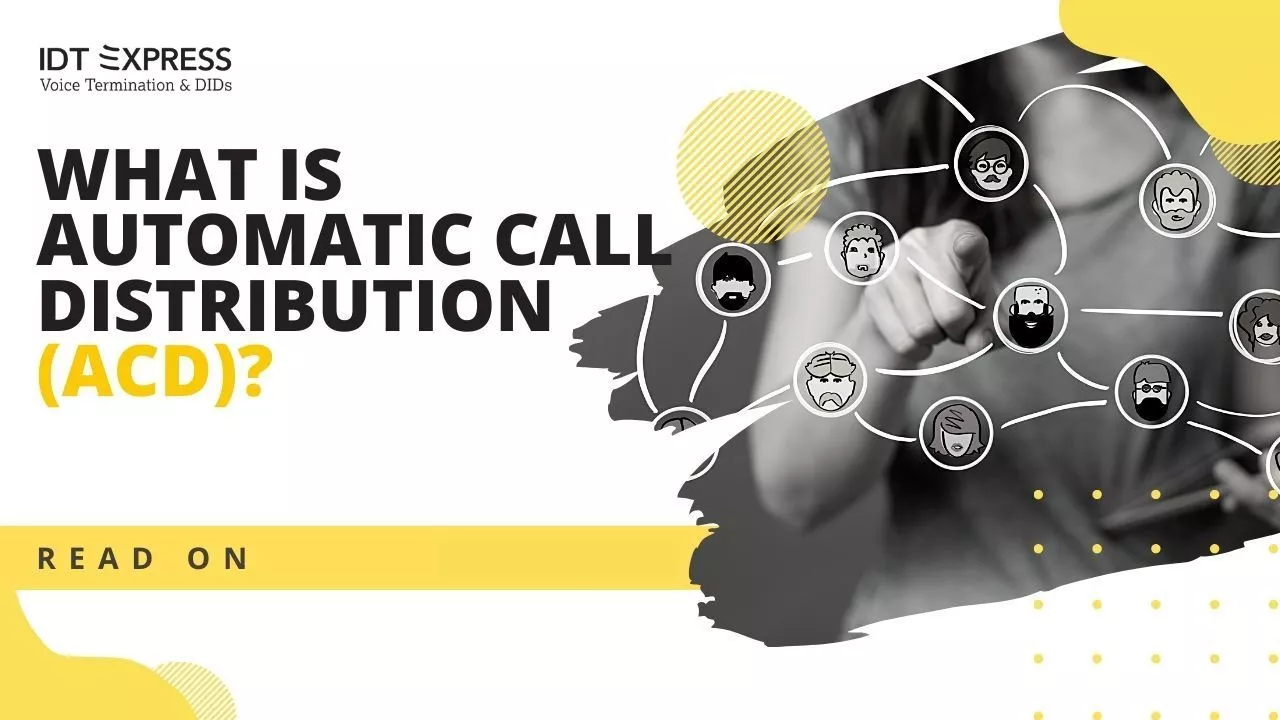Since customer experience is a critical market differentiator now, it is essential to ensure that consumers meet with a satisfactory response, if they reach out to your organization with questions or problems. Your call center or contact center must therefore be able to direct incoming calls to the individual or department most qualified for handling each query. That’s where Automatic Call Distribution or ACD comes into the picture.
What is Automatic Call Distribution (ACD)?
Automatic Call Distribution (ACD) is a software-based telephony feature that automatically receives incoming calls and distributes them to a specific individual or business department, based on a set of rules. ACD is typically an integral part of communications systems based on Voice over Internet Protocol (VoIP), a technology that converts voice signals into data packets that can be transferred over the internet and other data networks.

[Image source: TalkDesk]
An ACD system aids in assigning incoming calls to the contact center agent most qualified to assist customers with their specific issue. In this way, Automatic Call Distribution helps to eliminate unnecessary and frustrating call transfers, and long periods spent on Hold. ACD can also be instrumental in enabling organizations to increase their first call resolution rates for customer service and support issues.
Automatic Call Distribution usually works in conjunction with Interactive Voice Response (IVR), the automated system that guides customers along particular call paths based on their answers to questions about the reasons for their call. So if a caller responding to IVR presses a particular key to indicate a certain type of issue, Automatic Call Distribution technology then steps in to direct their call to the most appropriate agent or department.
Methods for Distributing Calls
Automatic Call Distribution (ACD) is a software-based telephony feature that automatically receives incoming calls and distributes them to a specific individual or business department, based on a set of rules. ACD is typically an integral part of communications systems based on Voice over Internet Protocol (VoIP), a technology that converts voice signals into data packets that can be transferred over the internet and other data networks.

[Image source: JustCall]
Automatic Call Distribution uses predetermined rules to identify callers, then assign them to queues, prior to routing each call to a particular agent or department. ACD systems use algorithms to determine how to route incoming calls. These routines are based on a number of criteria, the most common of which include the following:
Skills-Based Routing
Based on caller responses to questions asked by an IVR system, skills-based distribution algorithms connect callers to specific agents, based on the agent’s ability to handle the caller’s particular issue or query.
Fixed Order Routing
Also known as linear distribution, here agents are assigned fixed positions in a call answering list. If the first agent on the list is unable to answer a call, the caller is routed to the next agent on the list until someone responds.
Rotary, Circular, or Round-Robin Distribution
In this model, calls are distributed in a continuous loop, with the next agent on the list eligible to take a call only after the previous agent has dealt with a case. Once the last agent in the loop has taken a call, the cycle begins again. This system is often favored by sales teams, and gives all agents in the team an opportunity to make sales.
Idle Time Distribution
To help in evenly distributing case handling workloads, this system routes calls according to which agent has not taken a call for the longest amount of time.
Simultaneous Distribution
For call centers whose priority is to reduce customer waiting times, simultaneous distribution sends an incoming call to all agents within a particular ring group, increasing the customer’s chances that a live agent will answer their call.
Time-Based Routing
Organizations with a remote or geographically dispersed workforce can benefit from this model, which routes calls according to agent and caller time zones, and agent availability. This makes it more likely that, whatever time of day a caller tries to contact the organization, an agent in their time zone will be available. If no agents are available, there is also the option for routing calls to voicemail.
Smart Routing
ACD systems with Artificial Intelligence (AI) features may support data-based call distribution or smart routing. Here, callers are first assessed on the basis of criteria such as purchasing history and demographics, to determine which agent is best able to assist them. This model is often used for profit generation, rather than time saving.
Signs that You Need Automatic Call Distribution (ACD)
Automatic Call Distribution (ACD) can provide an answer, if your organization has to contend with any of the following seven issues:
1. Customers are Complaining About Not Being Able to Contact You
This is a clear sign that there’s a problem somewhere in your communications pipeline. The situation is serious, as customers unable to get through to you will look for alternatives — such as another company that offers better access to its support agents.
An ACD system using (for example) fixed order or simultaneous distribution can provide a solution, and make it easier for your customers to stay in touch.
2. Issue Resolution is Taking Too Long
If it’s taking an unusually long time to resolve queries or customer service issues, this may be an indication that your support agents are either overworked, or under-qualified for dealing with specific issues. In either case, long resolution times breed customer dissatisfaction.
Automatic Call Distribution powered by a skills-based algorithm can help ensure that customers are routed to the agent or department best qualified to address their needs.
3. You Want to Optimize Wait Times and Manage Huge Call Volumes
Depending on the size of your organization and the nature of your business, you may routinely have to field large volumes of calls. At all times, while keeping callers on hold is a valid option, you must guard against making customers wait too long before they got some kind of response. It’s also a good idea to do whatever you can to make this waiting period as painless as possible.
Over 60% of customers are unwilling to wait on hold for even one minute, What’s more, the majority of customers who hang up the phone after being kept on hold for too long won’t bother calling back.
ACD software typically includes an automatic “callback” feature, which can eliminate the need for customers to wait on Hold. Systems may include options for specifying the date and time of the call so you can work it into your schedule, further helping to decongest busy phone lines.
4. Your Agents are Not Being as Productive as They Should
Inexperienced support agents or workers new to the organization may be tempted to pass difficult customer queries on to other more experienced agents, thereby increasing their workload and reducing their productivity.
Automatic Call Distribution using smart routing or skills-based routing can guard against this, maintaining a balance between the expertise needed for dealing with customer issues, and the fair distribution of the call volume between service agents.
5. You Need to Manage a Distributed Workforce
Many organizations now operate with a mix of office or home-based and remote workers, some of whom may be geographically dispersed. This creates both a management burden (optimizing the distribution of work across the various zones), and an opportunity to cater for consumers in a wide range of locations.
ACD systems using time-based routing can be instrumental here, by helping to maintain a presence for your organization across time zones and geographical regions that enables customers to contact you from any location, and at any time of day.
6. You Need to More Easily Identify VIP Clients and Nuisance Callers
Nuisance calls are a problem for businesses in all sectors, while some companies rely heavily on the patronage of certain key clients to maintain their bottom line.
With Automatic Call Distribution, it’s possible to configure systems to immediately identify VIP clients and route them to appropriate agents, or send them to the top of the call waiting queue. On the other side of the equation, you can use the system to blacklist unwanted phone numbers and drop calls from them automatically, freeing up your capacity to deal with genuine customers.
7. You Need to Integrate ACD with Other Business Communication Features
While using Automatic Call Distribution in isolation can streamline and optimize your voice communications, integrating ACD with other business software and platforms can provide more benefits for the organization.
For example, integrating it with your Customer Relationship Management (CRM) platform that can help you gain greater control over Call Routing, Autodials, Inbound Widgets, Workflows, and Analytics.
What’s more, with IDT’s Bring Your Own Carrier option (IDT BYOC), you’ll experience unmatched call quality, intelligent routing, and advanced voice features with a system that offers your organization increased global coverage.
If you’re having issues relating to Automatic Call Distribution (ACD), then IDT can help. To learn more, get in touch with us.




